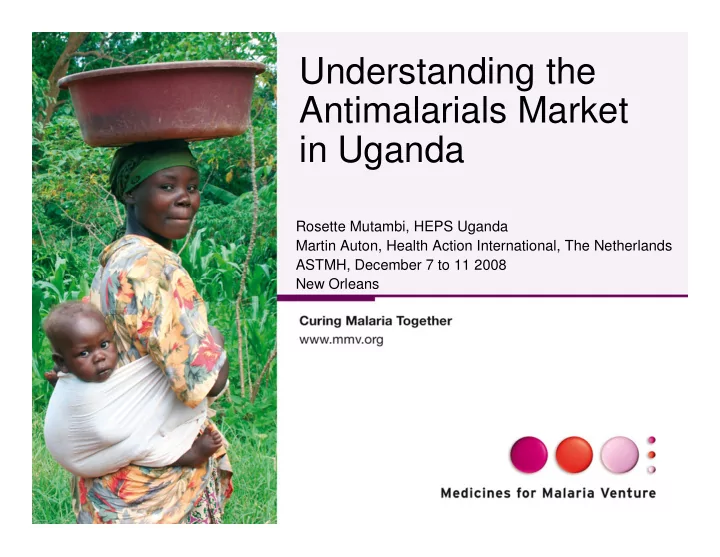

Understanding the Antimalarials Market in Uganda Rosette Mutambi, HEPS Uganda Martin Auton, Health Action International, The Netherlands ASTMH, December 7 to 11 2008 New Orleans New Orleans
Key findings 1. Recommended treatment is provided free in the public/mission facilities, but is not always available 2. ACTs are many times more expensive than the older ineffective medicines 3. Complete courses of all antimalarial medicines are unaffordable to a significant proportion of the population 4. A family has to choose between basic needs like food and education, or purchasing medicines for the treatment of malaria 5. Components of the final patient price are very different for different types of medicines in different types of outlet (e.g. manufacturers selling price, supply chain mark-ups) 6. Study provides an evidence base to guide initiatives to replace older ineffective medicines with ACTs
• Availability of product by outlet type • Range of prices • Affordability • Affordability • Supply chain structure & mark-ups • Management & rational use
Methodology Evolved from the WHO/HAI Medicine Prices • Methodology [www.haiweb.org/medicineprices] Census approach across 9 districts of Uganda • everywhere selling medicines: • • 750 outlets: public, mission & for-profit; formal & informal all antimalarial medicines found: • • 174 different entities, formulations, strengths and manufacturer permutations Mapped outlet spatial locations using GPS • Supply chain and mark-ups investigated in Kampala (capital city & main • commercial centre) plus 2 study districts Medicines for Malaria Venture in collaboration with Ministry of Health • and Civil Society (HEPS) June – September 2007 •
Access to free public sector treatment can be limited Only 16% of the outlets located in some Districts provided public sector care public sector care (84% being for-profit)
Access to free public sector treatment can be limited Only 50% of public health facilities in some districts had any of the first-line recommended treatment (ACT: artemether-lumefantrine)
Access to licensed outlets can be relatively low As many as 45% of the outlets in some districts were not supposed to sell medicines (i.e. not licensed, informal)
Effective medicines are more expensive ACTs: up to 60 times more expensive compared to older (ineffective) antimalarials
Effective medicines are unaffordable 11 days average household income to purchase a single course of ACT for a 5 year old child
Effective medicines are unaffordable A family would need to forego 62 days of basic food in order to afford annual needs of ACTs from the private sector
The poor cannot afford the cheapest medicines The poorest 40% population cannot even afford the price of the cheapest antimalarial found on the market (chloroquine)
Unaffordability contributes to irrational use Only 50% purchased a full course of even the lower priced (ineffective) antimalarials
ACTs are unaffordable so not widely stocked by the private sector As few as 4% of private sector outlets in some districts stocked ACTs
Price structures vary widely between products & sectors As much as 90% of the final patient price in Uganda can be the retail mark-up SP Clinic (locally produced) 90% CQ Drug shop (locally 68% produced) SP Clinic (imported) 63% ACT Clinic (imported) 60% SP Pharmacy (imported) 46% ACT Mission (imported) 27%
Conclusions • The public and private sectors are both significant providers of antimalarial medicines • ACTs are not always available in the public sector and are unaffordable in the private sector • Different interventions are needed for the public and private • Different interventions are needed for the public and private sectors in order to increase access for all of the population • There is a private sector supply chain to the village level (the older ineffective medicines get there) • This study provides an evidence base for policy makers in Uganda and internationally to guide initiatives to replace older, ineffective medicines with ACTs
Using the evidence: a pilot study to assess the impact of making subsidized ACTs available via the private sector Political buy-in Widen distribution through OTC status Training providers Supply chain incentives to sell lower priced product Generating demand for ACTs Tracking progress & impact
Using the evidence: Civil Society • Expanding the understanding of impact of medicine prices and availability on health • Developing simple messages on medicine prices and availability for different audiences • Engaging policy makers at different levels to be aware of Engaging policy makers at different levels to be aware of impact of price and availability on health • Public and media debates • Justification for allocating for improving medicine management and money for medicines (Ministry of Finance) • Using the evidence to monitor whether access expands to the poor
“350 Ugandan children die every day due to malaria in my country. This report provides clear evidence on how we can make life-saving ACTs available to this vulnerable population.” Hon. Dr. Stephen Mallinga, Minister of Health, Uganda
Affordability assumptions • Family size 5.2: 2 x adults 1 • Typical age structure: 1 x 15yrs; 1 x 7yrs; 1 x 2yrs 2 • Annual malaria episodes: 2yr old: 4x; 7yr old: 3x; 15yr old & adults: 2x 3 • Average income = cash plus inkind 1 • Food needs: 2,100 K/cal per day 4 • Full treatment courses • Median prices of medicines and food items 1. 2005/6 Uganda National Household Survey 2. 2002 Uganda National Census 3. Ministry of Health 4. WFP/UNICEF
Recommend
More recommend